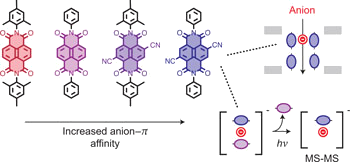- Dawson, R. E.; Hennig, A.; Weimann, D. P.; Emery, D.; Ravikumar, V.; Montenegro, J.; Takeuchi, T.; Gabutti, S.; Mayor, M.; Mareda, J.; Schalley, C. A.; Matile, S. “Experimental Evidence for the Functional Relevance of Anion-π Interactions” Nat. Chem. 2010, 2, 533-538

Attractive in theory and confirmed to exist, anion-π interactions have never really been seen at work. To catch them in action, we prepared a collection of monomeric, cyclic and rod-shaped naphthalenediimide transporters. Their ability to exert anion-π interactions was demonstrated by electrospray tandem mass spectrometry in combination with theoretical calculations. To relate this structural evidence to transport activity in bilayer membranes, affinity and selectivity sequences were recorded. π-acidification and active-site decrowding increased binding, transport and chloride > bromide > iodide selectivity, and supramolecular organization inverted acetate > nitrate to nitrate > acetate selectivity. We conclude that anion-π interactions on monomeric surfaces are ideal for chloride recognition, whereas their supramolecular enhancement by π,π-interactions appears perfect to target nitrate. Chloride transporters are relevant to treat channelopathies, and nitrate sensors to monitor cellular signaling and cardiovascular diseases. A big impact on organocatalysis can be expected from the stabilization of anionic transition states on chiral π-acidic surfaces.
DOI: 10.1038/nchem.657
open archive unige:8409 • pdf ![]()
